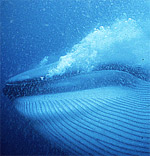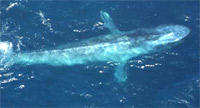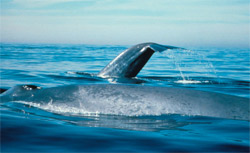|
Blue whales were abundant in most oceans around the world until the beginning of the twentieth century. For the first 40 years of that century they were hunted by whalers almost to extinction. Hunting of the species was outlawed by the international community in 1966. A 2002 report estimated there were 5,000 to 12,000 Blue whales worldwide located in at least five groups. More recent research into the Pygmy subspecies suggest this may be an under-estimate. Before whaling the largest population (202,000 to 311,000) was in the Antarctic but now there remain only much smaller (around 2,000) concentrations in each of the North-East Pacific, the Antarctic, and the Indian Ocean. There are two more groups in the North Atlantic and at least two (possibly more) in the Southern Hemisphere.
|
|

The long and tapered whale: The Blue whale has a long tapering body that appears stretched in comparison with the much stockier appearance of other whales. The head is flat and U-shaped and has a very prominent ridge running from the blowhole to the top of the upper lips.
 Lots of plates:
The front part of the mouth is thick with baleen plates; around 300 plates (each one meter long) hang from the upper jaw, running half a meter back into the mouth. Between 60 and 90 grooves (called ventral pleats) run along the throat parallel to the body. These pleats assist with evacuating water from the mouth after lunge feeding. Lots of plates:
The front part of the mouth is thick with baleen plates; around 300 plates (each one meter long) hang from the upper jaw, running half a meter back into the mouth. Between 60 and 90 grooves (called ventral pleats) run along the throat parallel to the body. These pleats assist with evacuating water from the mouth after lunge feeding.
Varying fin shape: The dorsal fin is small, visible only briefly during the dive sequence. It varies in shape from one  individual to another; some only have a barely perceptible lump, whilst other fins are quite prominent and falcate(sickle shaped). It is located around three-quarters of the way along the length of the body. individual to another; some only have a barely perceptible lump, whilst other fins are quite prominent and falcate(sickle shaped). It is located around three-quarters of the way along the length of the body.
A spectacular column of water :
When surfacing to breathe, the Blue whale raises its shoulder and blow hole region out of the water to a greater extent than other large whales (such as the Fin or Sei). This can often be a useful clue to identifying a species at sea. Whilst breathing, the whale emits a spectacular vertical single column blow (up to 12 m, typically 9 m) that can be seen from many kilometers on a calm day. Its lung capacity is 5,000 liters.
Mottled Flippers: The flippers are three to four meters long. The upper side is gray with a thin white border. The lower side is white. The head and tail fluke are generally uniformly gray  colored whilst the back, and sometimes the flippers, are usually mottled. The degree of mottling varies substantially from individual to individual. Some may have a uniform gray color all over, whilst others demonstrate a considerable variation of dark blues, grays and blacks all tightly mottled. colored whilst the back, and sometimes the flippers, are usually mottled. The degree of mottling varies substantially from individual to individual. Some may have a uniform gray color all over, whilst others demonstrate a considerable variation of dark blues, grays and blacks all tightly mottled.
The largest animal ever! The Blue whale is believed to be the largest animal ever to have lived on Earth. The largest known dinosaur of the Mesozoic era was the Argentinosaurus, which is estimated to have weighed up to 90 tonnes (100 short tons). There is some uncertainty as to the biggest Blue whale ever found. Most data comes from Blue whales killed in Antarctic waters during the first half of the twentieth century and was collected by whalers not well-versed in standard zoological measurement techniques. The longest whales ever recorded were two females measuring 33.6 m and 33.3 m (110 ft 3 in and 109 ft 3 in) respectively. However, there are some disputes over the reliability of these measurements. The longest whales measured by scientists at the American National Marine Mammal Laboratory (NMML) was 29.9 m long (98 ft) — about the same length as a Boeing 737 airplane or three double-decker buses.

Krill eaters: Blue whales feed exclusively on krill. The whales always feed on the highest concentration of krill that they can find. This means that they typically feed at depth (more than 100 m) during the daytime, and only surface feed at night. Dive times are typically ten minutes when feeding. Diving for twenty minutes is quite common. The longest recorded is thirty-six minutes (Sears 1998). The whale feeds by lunging forward at groups of krills, taking the animals and a large quantity of water into the mouth at once. The water is then squeezed out through the baleen plates by pressing the ventral pouch and tongue up against the water. Once the mouth is clear of water, the remaining krill, unable to pass through the plates, are swallowed. According to Ted Dewan's Inside the Whales and Other Animals, as well as krill, the Blue whale filters small fish and squid. It may even swallow something else that was also feeding on the krill.
 The loudest animal we can't hear:
The Blue whale is the loudest animal in the world. Estimates suggest that source level of sounds made by Blue whales are between 155 and 188 decibels when measured at a reference pressure of one micropascal at one meter. By comparison, a pneumatic drill is about 100 dB. A human, however, would likely not perceive the Blue whales as the loudest of all animals. All Blue whale groups make calls at a fundamental frequency of between 10 and 40 Hz, and the lowest frequency sound a human can typically perceive is 20 Hz. Blue whale calls last between ten and thirty seconds. Additionally Blue whales off the coast of Sri Lanka have been recorded repeatedly making "songs" of four notes duration lasting about two minutes each, reminiscent of the well-known Humpback whale songs. Researchers believe that as this phenomenon has not been seen in any other populations, it may be unique to the B. m. brevicauda (Pygmy) subspecies. The loudest animal we can't hear:
The Blue whale is the loudest animal in the world. Estimates suggest that source level of sounds made by Blue whales are between 155 and 188 decibels when measured at a reference pressure of one micropascal at one meter. By comparison, a pneumatic drill is about 100 dB. A human, however, would likely not perceive the Blue whales as the loudest of all animals. All Blue whale groups make calls at a fundamental frequency of between 10 and 40 Hz, and the lowest frequency sound a human can typically perceive is 20 Hz. Blue whale calls last between ten and thirty seconds. Additionally Blue whales off the coast of Sri Lanka have been recorded repeatedly making "songs" of four notes duration lasting about two minutes each, reminiscent of the well-known Humpback whale songs. Researchers believe that as this phenomenon has not been seen in any other populations, it may be unique to the B. m. brevicauda (Pygmy) subspecies.

Mysterious mating: Mating starts in late autumn, and continues to the end of winter. Little is known about mating behavior or even breeding grounds. Females typically give birth at the start of the winter once every two to three years after a gestation period of ten to twelve months. The calf weighs about two and a half tonnes and is around 7 m in length. Weaning takes place after about six months, by which time the calf has doubled in length. Sexual maturity is typically reached at eight to ten years by which time males are at least 20 m long (or more in the southern hemisphere). Females are larger still, reaching sexual maturity around 21 m or around the age of five.
 Eighty year olds? Scientists estimate that Blue whales can live for at least eighty years; however, since individual records do not date back into the whaling era, this will not be known with certainty for many years yet. The longest recorded study of a single individual is thirty-four years, in the north-east Pacific (reported in Sears, 1998). The whales' only natural predator is the Orca. Some reports claim that as many as 25% of mature Blue whales have scars resulting from Orca attacks. The rate of mortality due to such attacks is unknown. Eighty year olds? Scientists estimate that Blue whales can live for at least eighty years; however, since individual records do not date back into the whaling era, this will not be known with certainty for many years yet. The longest recorded study of a single individual is thirty-four years, in the north-east Pacific (reported in Sears, 1998). The whales' only natural predator is the Orca. Some reports claim that as many as 25% of mature Blue whales have scars resulting from Orca attacks. The rate of mortality due to such attacks is unknown.

Beaching themselves to breathe: Blue whales strandings are extremely uncommon and, because of the species' social structure, mass strandings are unheard of. However, when strandings do occur they can become quite a public event. In 1920, a Blue whale washed up near Bragar on the Isle of Lewis in the Outer Hebrides of Scotland. It had been shot in the head by whalers, but the harpoon had failed to explode. As with other mammals, the fundamental instinct of the whales was to try to carry on breathing at all costs, even though this meant beaching to prevent itself from drowning. Two of the whales's bones were erected just off a main road on Lewis, and remain a tourist attraction.
All text is available under the terms
of the GNU Free Documentation License
|
